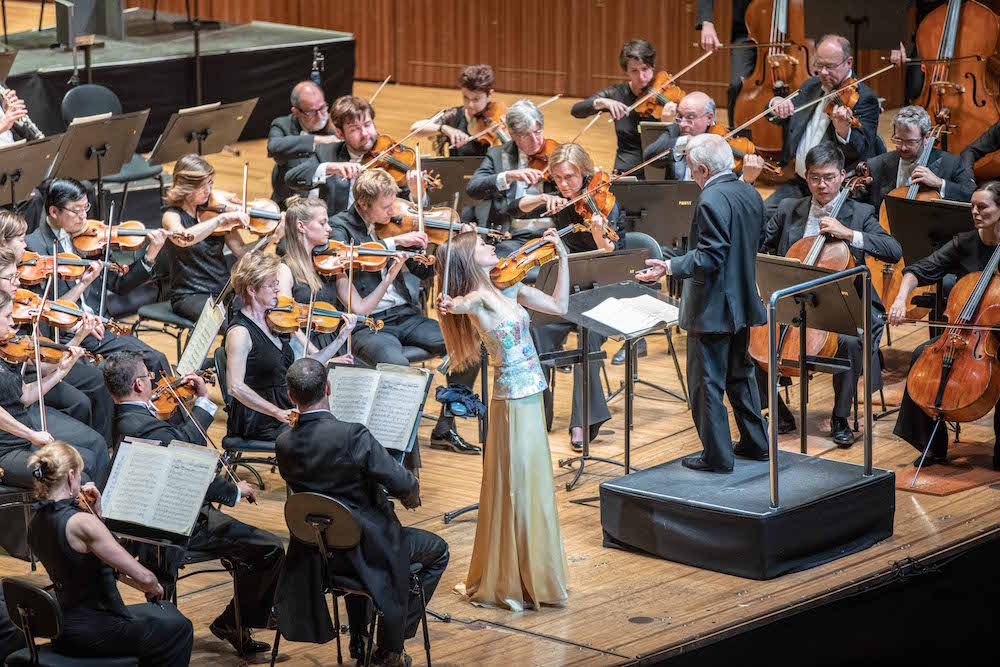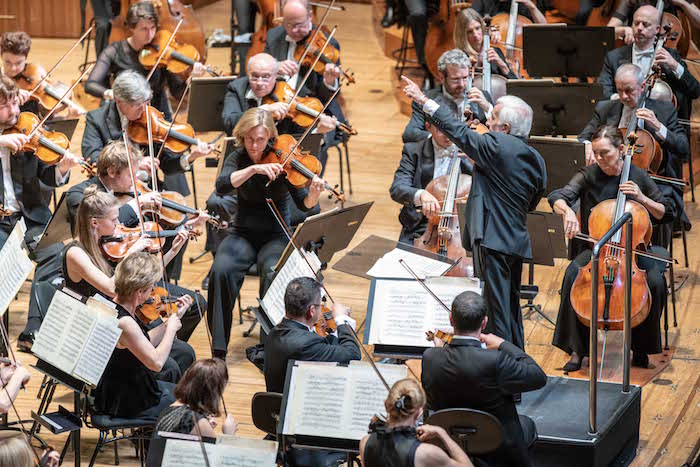Concert Hall, Sydney Opera House
September 19, 2018
Arabella Steinbacher plays with such pronounced calm that you’d be quite forgiven for thinking that the Bruch violin concerto is mere child’s play to someone of her stature. But soon enough, you realise that her unflappable stage demeanour is in fact intense concentration, and what emerges is a perfectly judged reading that breathes new life into a decidedly musty old gem.
 Arabella Steinbacher with Vladimir Ashkenazy and the Sydney Symphony Orchestra. Photo © Daniela Testa
Arabella Steinbacher with Vladimir Ashkenazy and the Sydney Symphony Orchestra. Photo © Daniela Testa
It’s an account somewhat on the expansive side, but don’t let that fool you into thinking that Steinbacher is in any way indulgent. Try perfectly measured instead, with thoughtful, lucid playing that makes this old warhorse come up very fresh indeed. Displaying her trademark security and rich tone, Steinbacher’s approach to the first movement demonstrated an appropriately withdrawn, almost self-effacing quality. Lovingly shaded, she subtly gestured to the music’s almost improvisatory nature whilst almost being insouciant about its obvious beauty.
Her playing of the Adagio was something to be cherished, elastically dispatched with a poignant tenderness that eschewed stodgy sentimentality. Elsewhere, her precision in swift passagework was unimpeachable – her multi-stopped rhythms in the finale were pungent and crisp, a demonstration of impetuous ardency that thrilled.
The Sydney Symphony was on top form under Vladimir Ashkenazy, whose entrance was greeted with real love by an audience welcoming back its old chief. The orchestra played with quicksilver agility for him, excelling in the extended tutti of the first movement and providing real moments of intensity where required. The cello section’s brief interplay with Steinbacher was delightful, and there was a sense of real give and take across the board.
 Vladimir Ashkenazy and the Sydney Symphony Orchestra. Photo © Daniela Testa
Vladimir Ashkenazy and the Sydney Symphony Orchestra. Photo © Daniela Testa
Steinbacher returned for a much-appreciated encore, giving the first movement of Prokofiev’s Sonata for Solo Violin. Like the Bruch, this was sweetly played and beautifully coloured, with a sense of knowing weaved throughout.
Earlier, the orchestra gave a very fine rendition of Tchaikovsky’s Fantasy Overture. Carefully shaped, with much attention given to dynamic contrasts, the players achieved a sense of organic drama that was absorbing. Strings were in particularly fine fettle, alternating easily between singing lines and sharp attacks, while the trumpets were cold and bracing where needed. The love theme was also deployed with a great sense of intimacy, offset by undercurrents of menace sown by Ashkenazy from the piece’s very beginning.
Bringing the evening to a satisfying finish were highlights, selected by Ashkenazy himself, from Prokofiev’s most famous ballet, Romeo and Juliet. Last performed by the orchestra under his baton in 2009, Ashkenazy has championed the work over his career and his affection for the music clearly shined.
A dramatically rich account, he found the humour and requisite swagger of The Montagues and the Capulets, which gave way to the entertainingly desultory sway of Dance of the Antilles Girls. Young Juliet was characterised by beautifully delicate string articulation, while the hushed opening of Romeo and Juliet was poignantly gorgeous. Ashkenazy drew from the orchestra superb rhythmical accuracy and blazing intensity in the Death of Tybalt, the cellos and basses digging into the accents with real vim. And Juliet’s Death was unbearably moving, an eloquent conclusion to this rich evening.
Sydney Symphony Orchestra’s Ashkenazy’s Romeo and Juliet is at the Concert Hall, Sydney Opera House, September 21 and 22











Comments
Log in to join the conversation.